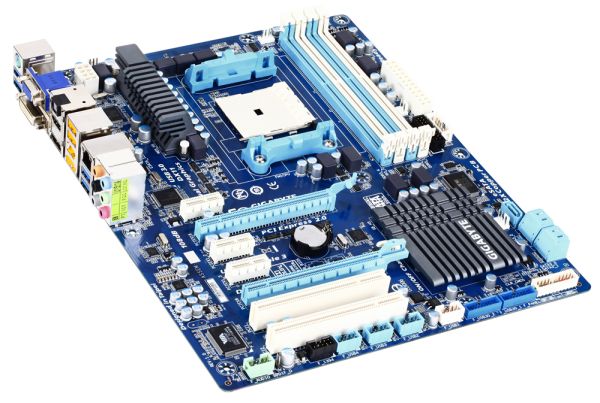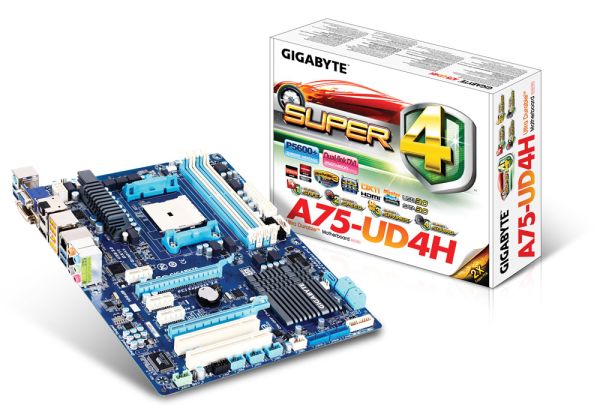ASUS F1A75-V Pro vs. Gigabyte GA-A75-UD4H – Llano at ~$120
by Ian Cutress on November 7, 2011 6:00 AM EST- Posted in
- Motherboards
- Gigabyte
- Asus
- A75
Overview of the Gigabyte GA-A75-UD4H
After having this board on the review test bed for a few days now, nothing immediately strikes me from the Gigabyte board. The overclock capability was quite good, despite the lack of overclock options.
The PCIe layout is a good one from which some other motherboard manufacturers can learn, and the IO panel is nicely full of USB ports. The position of the SATA port sticking out of the board, and the fan header next to it, is such that a second GPU will not hinder them. This also shows that some thought has gone to this area of the board!
I am quite disappointed by the fan control, especially compared to the ASUS board, which on this GA-A75-UD4H is limited in the BIOS and not expanded thoroughly by software in the OS. The BIOS is also still the old non-graphical style, and we’ll have to wait until X79 to get our hands on what Gigabyte has done in that respect.
At $115, the GA-A75-UD4H represents a board of good design, a three year warranty, but is let down by the options offered by software.
Visual Inspection
In terms of visuals, the GA-A75-UD4H sports a blue and white livery indicative of Gigabyte’s non-high end motherboards.
The 8+2 PWM design powers the large AMD socket, with VRM heatsinks which rock fairly easily under pressure. Around the socket are three fan headers, a SYS fan on the top left, a CPU fan in the top right and a PWR fan to the right of the DIMM slots. The socket area is fairly clear, allowing for large air coolers as required.
The GA-A75-UD4H sports a TPM header, and five SATA 6 Gbps ports. Four of these ports are at 90º to the board, and the other sticks out of it. The position of this port is such that if the user has two large PCIe cards in the board, this port is still accessible, as well as the SYS fan next to it.
The PCI/PCIe slot layout is a good choice for this board, with a PCIe x1 at the top, then a PCIe x16, two PCIe x1, another PCIe x16 (down to x8/x8 in dual GPU mode), and two PCI slots at the bottom. This allows sufficient space between dual GPU setups, as well as the top PCIe x1 for a first x1 card.
The IO panel is full of ports, namely 4 USB 3.0 (blue), two USB 2.0 (yellow), a PS/2 port, VGA, DVI-D, HDMI, DisplayPort, a S/PDIF optical output, an eSATA 6 Gbps port, FireWire, a Realtek gigabit Ethernet port, and typical audio jacks. I would have liked to see a Clear CMOS button, but with the IO this packed, I do not think there is space for it, unless they removed some features. It should be noted that, according to the Gigabyte website, the DVI-D does not support D-Sub by adaptor, and that when on integrated graphics, the connector cannot be changed while the motherboard is powered up.













47 Comments
View All Comments
DanNeely - Monday, November 7, 2011 - link
"It should be noted that, according to the Gigabyte website, the DVI-D does not support D-Sub by adaptor, and that when on integrated graphics, the connector cannot be changed while the motherboard is powered up."This sort of no plug and play nonsense is a throwback to the 90s, and has no business on a modern board.
Oberst - Monday, November 7, 2011 - link
This is quite misleading, as both mobos use a DVI-D. So also both do not support D-Sub via adapter, Gigabyte is just the only manufacturer that clearly stresses this issue, all others assume that you know what the difference between DVI-D and DVI-I is.Also no word is left, that the gigabyte board is capable of Dual Link DVI, while the asus only allows single link, which enables only a limited range of display resolutions. As Dual Link on Llano boards is not very common, that would surely be some important fact to mention.
I'm also not quite sure, what gigabyte means with "All integrated graphics ports do not support Hot plug. If you want to change to another graphics port when the computer is on, be sure to turn off the computer first." Maybe just a false translation, meaning you have to reboot the system, when changing the output (as the display driver doesn't switch the output automatically, you have to do that manually in the driver or by rebooting).
DanNeely - Monday, November 7, 2011 - link
It's the no-hotplug part that apalled me, I should've trimmed the 1st part of the sentence away to be clearer but was in a rush for the shower by the time I finished reading the articel.Oberst - Tuesday, November 8, 2011 - link
I'm not sure if that is really that strict as this statement shows. The Gigabyte translations are often not very good and the real meaning is quite different to the written text.When you change your display from DVI to DP, you have to do a reboot as the driver won't switch automatically. That's because you could just pull out a plug by hitting the cable accidentally. So the driver holds the primary output on the plug that was used before, only a reboot initiates a rescan of the displays and switches to another one.
So maybe gigabyte wanted to express this. That would definitely be something to try out. But i can't imagine that you cannot plug in a second monitor on a running system, that would really be some strange behavior.
Googer - Sunday, November 13, 2011 - link
Use a displayport adapter If you need DUAL LINK DVI connection on the ASUS board.Etern205 - Wednesday, November 9, 2011 - link
Yea, DVI-D doesn't support DVI to VGA adapter as there is no 4 analog pins on that DVI port. Also even if it doesn't have that 4 pin, the adapter still won't fit as the analog ground (that horizontal pin) on the adapter is a tad wider.Etern205 - Wednesday, November 9, 2011 - link
My mistake, looks like there is a DVI-D to VGA adapter and it's not the DVI to VGA adapter I was mentioning.DVI-D to VGA adapter
http://www.newegg.com/Product/Product.aspx?Item=N8...
DVI to VGA adapter
http://www.newegg.com/Product/Product.aspx?Item=N8...
cjs150 - Monday, November 7, 2011 - link
Really like layout of Gigabyte board. Although this is more of a problem with M-ATX boards I have struggled recently with fitting both graphics card with waterblock and a air cooler over the memory (fits but is incredibly tight) so seeing the PCIEx1 slot above the PCIex16 is a good move.What are all those legacy PCI slots doing there? What do people use them for? Across 5 computers at home I use 2 - I for a really old RAID card and one for a TV tuner. Is there really any need for them now?
Recently I have seen a board with right angled 24 pin ATX socket. Please can this become standard
Golgatha - Monday, November 7, 2011 - link
PCI is for your old sound card. Now if you're building new, there is no need for PCI to exist.Taft12 - Monday, November 7, 2011 - link
IDE controller, RS-232 card... Me and many like me still need a PCI slot, and Asus and Gigabyte's market research shows the same.PCI will still be with us for many years to come yet.